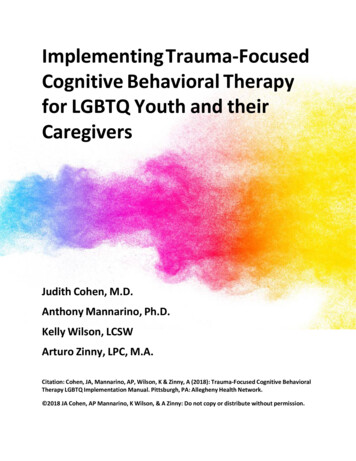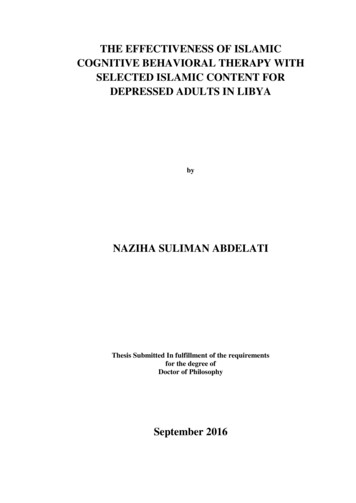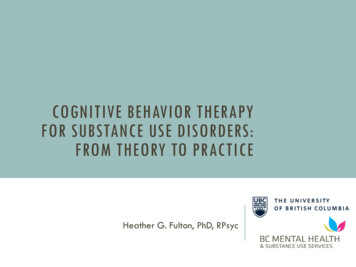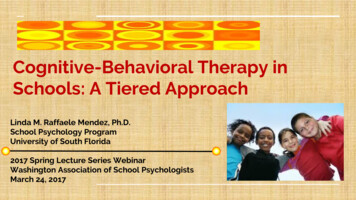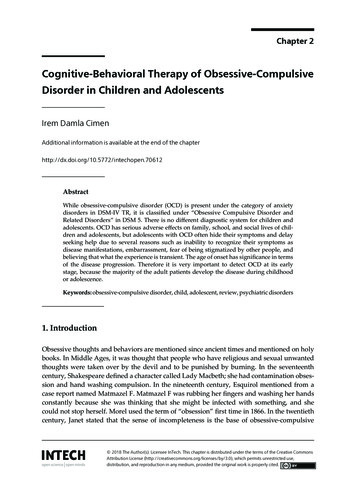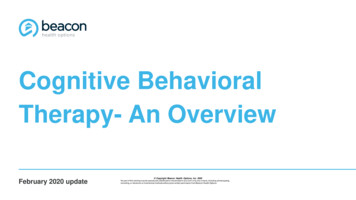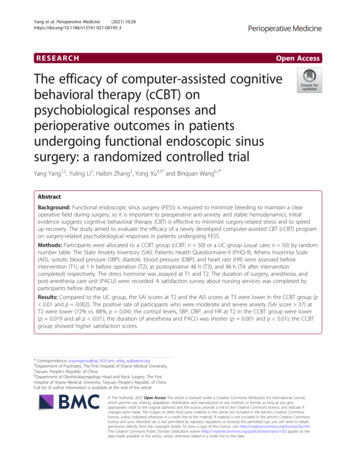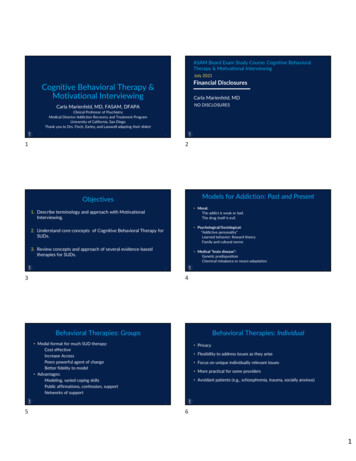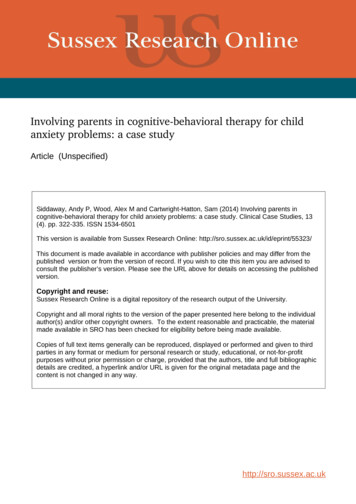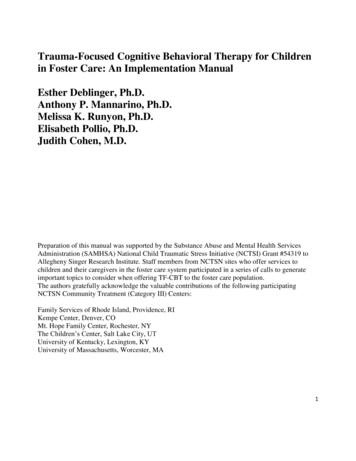
Transcription
Trauma-Focused Cognitive Behavioral Therapy for Childrenin Foster Care: An Implementation ManualEsther Deblinger, Ph.D.Anthony P. Mannarino, Ph.D.Melissa K. Runyon, Ph.D.Elisabeth Pollio, Ph.D.Judith Cohen, M.D.Preparation of this manual was supported by the Substance Abuse and Mental Health ServicesAdministration (SAMHSA) National Child Traumatic Stress Initiative (NCTSI) Grant #54319 toAllegheny Singer Research Institute. Staff members from NCTSN sites who offer services tochildren and their caregivers in the foster care system participated in a series of calls to generateimportant topics to consider when offering TF-CBT to the foster care population.The authors gratefully acknowledge the valuable contributions of the following participatingNCTSN Community Treatment (Category III) Centers:Family Services of Rhode Island, Providence, RIKempe Center, Denver, COMt. Hope Family Center, Rochester, NYThe Children’s Center, Salt Lake City, UTUniversity of Kentucky, Lexington, KYUniversity of Massachusetts, Worcester, MA1
Table of ContentsIntroduction .3Applicability of TF-CBT for Children in Foster Care . . .4Clinical Application of TF-CBT with Children Foster Care .10Review of TF-CBT Core Components .11Barriers to Effective Treatment for Children in Foster Care . .15Engaging the System in Implementation of TF-CBT .17Engaging Foster Parents in TF-CBT .20Legal Issues When Implementing TF-CBT with Children in Foster Care . 24Assessment Strategies and Measures .25TF-CBT Implementation with Children in Foster Care and Their Caregivers. .26Individual Work with Children in Foster Care. .27Individual Work with Foster Parents .36Conjoint Work with Youth and their Foster Parents .49Special Considerations for Involving the Biological Parent in the Child’s Treatment .50Special Considerations for Treatment When Parental Rights Are Terminated .54Special Considerations for Implementing TF-CBT with Foster Kinship Families .57Special Considerations for Implementing TF-CBT with Young Children . 62Special Considerations for Managing Possible Placement Changes . 65Special Considerations: Psychotropic Medication Use with Children in Placement .69Summary. .72Appendix A .74References .762
IntroductionAlmost half a million children may reside in foster care in the United States (U. S.) at anygiven time. According to the U. S. Department of Health and Human Services (2015), as ofSeptember 30, 2014, there were 415,129 children in foster care in the U. S. Among the children infoster care as of that date, 46% were in non-relative foster homes, 29% were in relative (i.e.,kinship) foster homes, 8% were in institutions, 6% were in group homes, and the remaining 11%were in other placement types (pre-adoptive homes, etc.). The median age of children in foster careat that time was 8.0 years; 52% were male and 48% were female. With regard to race/ethnicity,42% of the children were White, 24% were Black or African-American, 22% were Hispanic, 10%were other or multiracial, and the race/ethnicity of the remaining 3% was listed as unknown/unableto determine. The median amount of time spent in foster care was 13.3 months.It has been repeatedly documented that children in foster care often present with a history ofchildhood trauma including neglect, sexual abuse, physical abuse, and emotional abuse. One studyfound that the mean number of traumas experienced by children in placement in their sample was4.7 and for foster children considered to have complex trauma the mean number of traumas was 5.8(Greeson et al., 2011). A study of older adolescents in foster care noted that 80% of the sample hadone or more experiences that would be a qualifying trauma in the DSM-IV definition ofPosttraumatic Stress Disorder (PTSD) and almost 62% had experienced two or more DSMqualifying events (Salazar, Keller, Gowen, & Courtney, 2013). The rate of trauma exposure foryouth in foster care in this study was double the rate of trauma exposure for youth in the generalpopulation (Salazar et al., 2013). A review of the literature found that the majority of children infoster care had a history of multiple forms of maltreatment (Oswald, Heil, & Goldbeck, 2010).3
Among children in placement, this review documented rates ranging from 18-78% for neglect, 648% for physical abuse, 4-35% for sexual abuse, 8-77% for emotional abuse, and 21-30% for noavailable caregiver (Oswald et al., 2010). Parental substance abuse is a significant factor related tochildren being placed in foster care due to neglect. In fact, one study found a rate of parentalsubstance abuse of 51% among children placed into foster care for neglect (Takayama, Wolfe, &Coulter, 1998). A study of children in treatment foster care found that 93% of the children werereported to have experienced one or more traumas and almost one-half experienced four or moretypes of trauma (Dorsey et al., 2012). The number of experienced traumas may, in fact, have beenunderreported as the information came from treatment home parents who may not have had fullknowledge of the child’s trauma history.Applicability of TF-CBT for Children in Foster CareIt is well documented that children in foster care experience a wide range of significantdifficulties, including PTSD, depression, and behavior problems typically targeted by Traumafocused Cognitive Behavioral Therapy (TF-CBT; Cohen, Mannarino, & Deblinger, 2016;Deblinger, Mannarino, Cohen, Runyon, & Heflin, 2015). In an early study of PTSD in children infoster care, Dubner and Motta (1999) found that among 150 children in foster care (50 who weresexually abused, 50 who were physically abused, and 50 who were not abused), 64% of children inthe sexual abuse group, 42% of children in the physical abuse group, and 18% of children in thenon-abused group met criteria for PTSD. More recent research on posttraumatic stress amongchildren in foster care also has found clinically significant posttraumatic stress symptoms (e.g.,Greeson et al., 2011; Kolko et al., 2010) and high rates of the PTSD diagnosis (e.g., Keller, Salazar,& Courtney, 2010; McMillen et al., 2005). More specifically, among a nationally representative4
sample of 1848 children involved with the child welfare system, Kolko and colleagues (2010) foundthat posttraumatic stress symptoms were significantly higher among children removed from theirhomes as compared to children who remained at home. In another study, PTSD was the mostcommon diagnosis among older adolescents in foster care and was diagnosed at a rate significantlyhigher than in the general population (Keller et al., 2010).Diagnoses other than PTSD have been documented among children in foster care, includingAttention-Deficit/Hyperactivity Disorder, Oppositional Defiant Disorder, Conduct Disorder,depression, mood disorder, anxiety disorder, attachment disorder, and adjustment disorder (e.g.,dosReis, Zito, Safer, & Soeken, 2001; McMillen et al., 2005; Oswald et al., 2010). One studyexamining Medicaid claims from 44 states found that youth in foster care had higher rates acrossexternalizing disorder diagnoses, were more than 6 times as likely to be diagnosed with stressrelated disorders, and were more than twice as likely to be diagnosed with any disorder as comparedwith Medicaid youth not in foster care (Vanderwerker et al., 2014). Also using Medicaid claims,dosReis and colleagues (2001) found the prevalence of mental health diagnoses among children infoster care to be two times greater than children receiving Supplementary Security Income andalmost 15 times greater than youth receiving other types of aid. In addition to examining thediagnoses of children in foster care, many studies have utilized the Child Behavior Checklist(CBCL; Achenbach, 1991; Achenbach & Rescorla, 2001) to document internalizing andexternalizing difficulties among these children. Oswald and colleagues’ (2010) review of theliterature suggests that foster children generally have elevated values on the total problems scaleand subscales, and that 36-61% of children in foster care had scores over the cutoff for behaviorproblems.5
Research also has focused on the difficulties of adolescents in foster care. Pilowsky and Wu(2006) compared adolescents with and without placement into foster care; the adolescents who hadbeen placed in foster care exhibited more symptoms in every category assessed. The adolescentswith a foster care placement had more than twice the number of conduct symptoms, weresignificantly more likely to report suicidal ideation, were about three times more likely to presentwith eight or more anxiety symptoms, about four times more likely to present with seven or moresymptoms of disruptive behavior disorders, about four times more likely to have a history of suicideattempts, about two times more likely to use illicit drugs, about five times more likely to be drugdependent, and about two to four times more likely to have other substance use disorders (Pilowsky& Wu, 2006). Another study of adolescents in foster care found that 35% of the sample qualifiedfor a substance use disorder and that having a diagnosis of PTSD or Conduct Disorder increased thelikelihood of the use of multiple substances and being diagnosed with a substance use disorder(Vaughn, Ollie, McMillen, Scott, & Munson, 2007). Alcohol-related disorders and depression alsohave been noted among adolescents in foster care (e.g., Keller et al., 2010).Beyond mental health concerns, children and adolescents in foster care have high rates ofdevelopmental delays (e.g., Leslie et al., 2005; Pears & Fisher, 2005), physical health concerns(e.g., Szilagyi, Rosen, Rubin, & Ziotnik, 2015; Takayama et al., 1998), and educational challenges(e.g., Smithgall, Gladden, Howard, Goerge, & Courtney, 2004). Research also has documentedpsychobiological correlates of maltreatment for children in foster care (e.g., Bick et al., 2012;Linares et al., 2008).The Adverse Childhood Experiences (ACEs) research (e.g., Chapman et al., 2004; Dube etal., 2003; Felitti et al., 1998) has documented that trauma in childhood can lead to significant6
psychological and physical difficulties, including substance abuse, depression, heart disease, andcancer, that can persist well into adulthood and can even lead to an increased risk of prematuredeath. Further, the greater the number of ACEs/traumas experienced, the likelihood of difficultiesincreases in a strong and graded manner (e.g., Chapman et al., 2004; Felitti et al., 1998). Forexample, adults with a history of four or more ACEs were 10 times more likely to have injectedstreet drugs and 12 times more likely to have attempted suicide than adults with no history of ACEs(Felitti et al., 1998).The ACEs research is particularly relevant for children in foster care given reports that thesechildren often have experienced multiple traumas. Studies investigating the cumulative effects oftrauma among children in foster care also suggest this relationship of more trauma exposure leadingto significantly greater emotional and behavioral difficulties (e.g., Greeson et al., 2011; Raviv,Taussig, Culhane, & Garrido, 2010; Salazar et al., 2013; Seiler, Kohler, Ruf-Leuschner, & Landolt,2016). For example, Raviv and colleagues (2010) found that children ages 9 to 11 years in out ofhome care with more risk factors (including trauma exposure) were more likely to experienceanxiety, depression, posttraumatic stress, dissociation, sexual concerns, and externalizing behaviorproblems. Consistent with the adult ACEs literature, the symptom levels among these childrenincreased as the number of risk factors increased (Raviv et al., 2010). As another example, a studyof older adolescents in foster care documented that the teens who had experienced two or moretraumatic events were much more likely to meet PTSD criteria (22.5%) than those who hadexperienced one traumatic event (6.7%; Salazar et al., 2013).The lasting impact of difficulties among children who have been in foster care is alsosupported by research on foster care alumni. One study of foster care alumni found that 54.4% met7
criteria for one or more disorder in the 12 months prior to being interviewed (Pecora et al., 2005).Among those with one or more disorders, 25.2% were diagnosed with PTSD (a rate almost twicethat of U.S. war veterans at the time), 20.1% were diagnosed with major depression, and 17.1%with social phobia (Pecora et al., 2005).Although rates of mental health therapy utilization by foster children are higher thancommunity samples, there are still concerns that children in foster care are not receiving theservices they need (e.g., Bellamy, Gopalan, & Traube, 2010; Landsverk, Burns, Stambaugh, &Rolls-Reutz, 2006; Pecora, Jensen, Romanelli, Jackson, & Ortiz, 2009). Further, it is important toevaluate the effectiveness of the treatments that are being implemented with children in foster care.For instance, one study of children in long-term foster care found that the use of outpatient mentalhealth services had no significant impact on externalizing or internalizing behavior problems(Bellamy et al., 2010). Landsverk and colleagues (2006) indicated that evidence-based practiceshave not been utilized consistently in foster care settings. Given the high rates of mental healthdifficulties among children in foster care, it is critical that children in foster care receive effectivetreatment to help derail the potential negative mental health trajectory that too often leads to alifetime of difficulties.Trauma-focused Cognitive Behavioral Therapy (TF-CBT; Cohen et al., 2016; Deblinger etal., 2015) is the treatment for child trauma with the most research support (Morina, Koerssen, &Pollet, 2016), having demonstrated its efficacy in 20 randomized trials to date (Cohen et al., 2016).Several research studies on TF-CBT have included children in foster care among the samples buttwo studies evaluated the use of TF-CBT specifically with a foster care population. Lyons, Weiner,and Schneider (2006) conducted a quasi-experimental study of three evidence-based treatments for8
trauma (Child-Parent Psychotherapy, Structured Psychotherapy for Adolescents Responding toChronic Stress, and TF-CBT) provided to 216 children ages 3 to 18 years in foster care.Significantly greater improvements were associated with all three evidence-based treatments whencompared to a treatment as usual condition through the System of Care. The treatments were alsonoted to be effective across racial groups (Weiner, Schneider, & Lyons, 2009). Children in the TFCBT condition had significantly greater improvements in traumatic stress symptoms and behavioraland emotional needs as compared to children in the treatment as usual condition replicating theresults of previous comparisons of TF-CBT (Cohen, Deblinger, Mannarino, & Steer, 2004; Cohen& Mannarino, 1996; Deblinger, Lippmann, & Steer, 1996; Jensen et al., 2014). However, this studyalso documented that foster children in the TF-CBT condition were about one-tenth as likely to runaway from their placement and about half as likely to have a placement disruption as compared tochildren in the treatment as usual condition (Lyons et al., 2006). These are important outcomes forchildren in foster care, as this population has significant emotional and behavioral difficulties, asnoted above, and placement disruptions have been linked with increasing mental health problemsover time (e.g., Newton, Litrownik, & Landsverk, 2000).Dorsey, Pullmann, and colleagues (2014) conducted a randomized controlled trial withchildren and their foster parents comparing the standard implementation of TF-CBT with TF-CBTplus evidence-based engagement strategies based on strategies developed by McKay, Stoewe,McCadam, and Gonzalez (1998). Forty-seven children ages 6 to 15 years participated with one oftheir foster parents. Children in both conditions who completed at least four sessions improvedsignificantly on all outcome measures, which included assessments of posttraumatic stresssymptoms, internalizing and externalizing difficulties, depressive symptoms, and the children’s9
strengths. Children and foster parents in the TF-CBT plus engagement condition, however, weresignificantly more likely to complete at least four sessions and less likely to drop out of treatmentprematurely (Dorsey, Pullmann, et al., 2014). Given the importance of effective mental healthtreatment for children in foster care, the finding that evidence based engagement strategiesaddressing concrete as well as perceptual barriers resulted in higher rates of successful treatmentcompletion is critically important.Clinical Application of TF-CBT with Children in Foster CareAs the developers of TF-CBT (Cohen et al., 2016; Deblinger et al., 2015), we receivedsupport through Substance Abuse Mental Health Services Administration (SAMHSA) funding(Grant No #54319) to review and examine how TF-CBT, a widely used evidence based treatmentmodel for childhood trauma, could be applied most effectively to children and adolescents placedwith foster families. We worked closely and collaboratively with colleagues associated with theNational Child Traumatic Stress Network (NCTSN, www.nctsn.org) who were actively engaged inimplementing TF-CBT with foster families with the ultimate goal of creating a TF-CBTimplementation manual for therapists working with foster children and their caregivers. In order tomeet the goals of the project, we conducted bimonthly conference calls during which we engagedNCTSN clinicians in case discussions regarding TF-CBT implementation with foster families,while also brainstorming regarding TF-CBT adaptations for this population. Melissa Runyon,Ph.D., and Elisabeth Pollio, Ph.D., assisted with this project by contributing to the conference calls,collecting and organizing the information, reviewing the foster care literature, and serving as coauthors of this manual. We are also greatly appreciative of the foster caregivers who have sharedtheir wisdom and who have opened their hearts and their homes to children and adolescents during10
what is often the most difficult times of their lives. Thus, this manual represents the collectiveknowledge and clinical expertise of many talented therapists, supervisors, foster caregivers, andothers dedicated to ensuring children placed in foster care achieve optimal mental health outcomes.The overall goal of this manual is to offer guidance to clinicians and supervisors on adapting TFCBT to optimally address the unique circumstances of children in foster placement settings. Tobring to life the special challenges faced when implementing TF-CBT with foster families, weincluded many clinical examples throughout the manual. In order to protect the privacy of fosterfamilies, all clinical examples in this manual are composite case descriptions.Review of TF-CBT Core ComponentsTherapists preparing to implement TF-CBT with children in foster care should have basicTF-CBT knowledge and skills for treating diverse traumas experienced by children and theirfamilies. TF-CBT implementation is described in detail in several current texts (Cohen et al., 2016;Deblinger et al., 2015). In addition, other chapters/articles offer an overview of TF-CBTimplementation specifically with children in foster care and their foster parents (Dorsey &Deblinger, 2012; Dorsey, Conover, & Cox, 2014). Free of charge introductory online TF-CBTtraining is also available at www.musc.edu/tfcbt. To optimally utilize this TF-CBT foster caremanual, readers are encouraged to take advantage of the above texts, the free of charge onlinetraining, as well as other opportunities for face-to-face training and consultation in TF-CBTimplementation.Gradual exposure (GE) and Trauma RemindersA guiding principle of TF-CBT implementation is the importance of helping childrengradually face innocuous trauma reminders (e.g., trauma psychoeducation, environmental11
reminders, etc.) as well as the actual memories of the trauma(s) endured in the context of a safe,therapeutic environment. Many children who have a history of traumatic experiences and fosterplacement present with posttraumatic stress symptoms and exhibit a tendency to avoid thinking ortalking about and/or being in the presence of innocuous reminders of traumatic experiences. Suchavoidant tendencies are often counterproductive in relation to the healing and recovery process.Thus, TF-CBT is designed to gradually engage children and their foster caregivers in initialexposure to less anxiety provoking reminders such as general educational information abouttraumas and foster care before engaging in discussions and/or trauma narration about the child’sspecific traumatic experiences. This gradual process makes such trauma reminders much moretolerable for children. Although the process may produce some anxiety initially, it will ultimatelylead to feelings of strength rather than sparking the overwhelming negative feelings that wereexperienced at the time the trauma(s). Provided below are descriptions of additional centralprinciples of TF-CBT as well as a diagram highlighting the core PRACTICE components of thetreatment model (Deblinger et al., 2015).Components basedTF-CBT is a model that incorporates specific treatment components that build oneach other and are ultimately designed to be integrated in the final phase of treatment. The acronymPRACTICE is used to help clinicians not only remember each of the components which aredepicted below in Figure 1, but it also highlights the importance placed on practicing the skillstaught between treatment sessions and after therapy is completed.12
Figure 1Respectful of cultural valuesTF-CBT is designed for families of diverse ethnic, racial, religious, and culturalbackgrounds. Though the principles that guide therapy are universal in their application to allfamilies, it behooves clinicians to inquire about and tailor therapy to acknowledge and demonstraterespect for each the child and foster families’ backgrounds helping to provide a bridge across fosterparent’s and child’s cultural practices to support and enhance healing.13
Adaptable and flexibleTF-CBT allows for considerable flexibility such that clinicians are encouraged to use theirtalents and creativity to adapt the psychoeducation, skill building, and trauma narration/processingactivities to optimally serve the child and his/her family. Thus, clinicians may make adjustmentsthat reflect the child’s interests, developmental level, sexual identity and orientation, as well as theparticular foster family’s needs and circumstances.Family focusedAs noted above, TF-CBT is designed to engage children, adolescents, and nonoffendingcaregivers, thereby acknowledging the impact of traumatic stress effects on the child and, in thiscase, the entire foster family. Though challenging at times, this model is designed to activelyinclude and support the foster parent in serving as a therapeutic resource for the child as well. Infact, TF-CBT therapists are encouraged to spend at least half of each session with the fostercaregiver whenever possible.Therapeutic Relationship is centralThe therapeutic relationship with a child in foster care is critical to helping the childovercome common feelings of distrust that children experience as a result of unfortunateexperiences with authority figures removing them from home and separating them from importantattachment figures. A therapeutic relationship with foster parents is also critical to motivating theirtreatment participation and follow through.14
Self-EfficacyTF-CBT is a strength-based model as it builds on and helps to further develop children’s andcaregivers’ strengths in coping with trauma and other life stressors. Recent research, in fact, hasdocumented that TF-CBT not only reduces traumatic stress symptoms and other difficulties, but itappears to enhance children’s personal resiliency (Deblinger, Pollio, Runyon, & Steer, 2016). Thisis critical for children in care who are likely to face continued stressors as they cope withplacements stressors and as they navigate the complex child welfare system.Barriers to Effective Treatment for Children in Foster CareThere are numerous potential barriers to children in foster care receiving effective mentalhealth services. A qualitative study of improving foster parent engagement in TF-CBT, however,found that perceptual barriers were most emphasized by foster parents and caseworkers (Dorsey,Conover, et al., 2014). These perceptual barriers included negative prior treatment experiences,concern about the level of participation expected, fit with the therapist, distrust of the system,unclear information about the therapy process, and beliefs that the child might be more comfortablewith therapy provided in the school setting. Unsuccessful or less than optimal past experiences withtherapy (either the foster parent’s own or the foster child’s) can impact the foster parent’s view ofthe current therapy. Foster parents may not understand their critical role in the child’s therapy,especially if their past experience with a child’s treatment did not include their involvement.Similarly, caseworkers may not understand the critical importance of the foster parent’s role in thechild’s treatment and therefore may not emphasize the need for their participation. The view of thetherapist as part of the broader child welfare system can also be a perceptual barrier to engagingboth foster parents and foster children in treatment.15
There are also several concrete or practical barriers to children in foster care receivingeffective therapy. In the Dorsey, Pullmann, and colleagues study (2014), the concrete barriersmentioned were limited appointment times, overwhelming caregiving demands, and treatmentconvenience (preferring in-home therapy or therapy in the school setting). Foster parents may havemore than one child in the home and may be caring for other children with special needs. As aresult, it may be challenging for foster parents to juggle multiple appointments for the children,particularly if they also work outside of the home. There also may be challenges for caseworkerswith regard to arranging transportation and babysitting to ensure that the child and foster parent canparticipate in outpatient treatment. Therapists who are flexible with scheduling (and rescheduling)appointments, are able to provide in-home or school-based treatment, and try to prioritize fosterfamilies’ rather than the therapist’s scheduling needs, will go a long way towards engaging many ofthese families.The unpredictability of placement changes can be a potential barrier to treatment as well.Since foster home placements in most cases are not intended to be permanent, there may be somehesitation on the part of therapists to initiate TF-CBT until the child is in a more “permanent”placement. However, data suggests that, on average, placements last about a year (U. S.Department of Health and Human Services, 2015). Thus, the short-term nature of TF-CBT maymake it an ideal fit as most foster children are able to complete TF-CBT within 12-20 sessions. Iftreatment is initiated because the placement was thought to be stable but an unexpected placementchange occurs, this change in placement can disrupt therapy. However, research findings describedearlier suggest that TF-CBT (and/or the use of other evidence-based interventions) may enhance a16
child’s chances of remaining in a stable placement during the period of foster care (Lyons et al,2006).In sum, engagement strategies that have been found to be effective involve exploring andaddressing both the concrete and perceptual barriers noted above. Such strategies have been shownto increase the potential for success in initiating and completing treatment with children and theircaregivers (Dorsey, Pullmann, et al., 2014). Suggestions for specifically engaging foster caregiversare described below.Engaging the System in Implementation of TF-CBTChildren in the foster care system are undoubtedly a unique subpopulation of the overalltrauma population that we assess, diagnose, and treat. As outlined above, children who are placed infoster care are more likely than those who are not in foster care to present with a greater number oftraumatic events, higher levels of PTSD symptoms, more behavioral problems and other symptoms,and greater number of prescribed psychotropic medications. Given their level of trauma exposureand distress and the degree to which that distress is often misinterpreted or mishandled, it is criticalfor us to engage children in the foster care system and their caregivers in effective treatments, likeTF-CBT.One obstacle to engaging systems and child welfare workers to optimally address thetherapeutic needs of children in foster care may be a lack of education, knowledge, andunderstanding of the emotional and behavioral impact of child abuse, neglect, trauma, andplacement in foster care on children and adolescents. This knowledge gap is being addressed viarecently developed educational programs designed for local child protection workers, permanencyplanning workers, juvenile justice workers, and others who interact with children in the foster care17
system. More specifically, members of the National Child Traumatic Stress (NCTSN) havedeveloped the Child Welfare Trauma Training toolkit (Child Welfare Committee, 2008) to educatesystems’ workers about the prevalence and impact of childhood trauma, posttraumatic stresssymptoms, and how these symptoms manifest. This education is critical
given time. According to the U. S. Department of Health and Human Services (2015), as of September 30, 2014, there were 415,129 children in foster care in the U. S. Among the children in foster care as of that date, 46% were in non-relative foster homes, 29% were in relative (i.e.,
